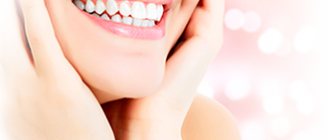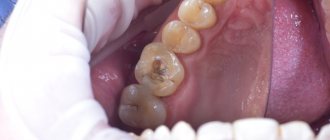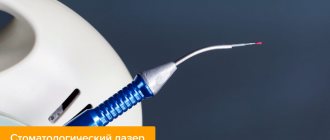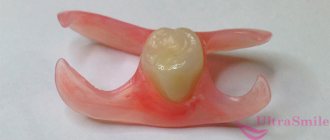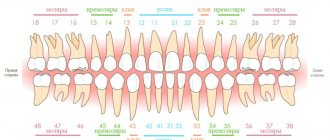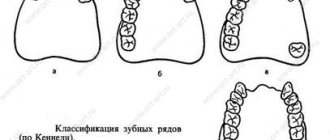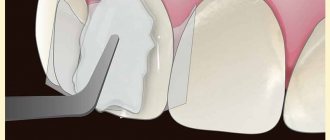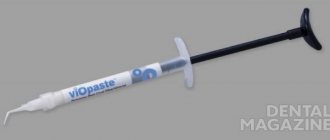Laser in dentistry
There are several types of dental laser: diode, argon, neodymium, erbium, carbon dioxide. The difference between the devices is in power, wavelength, point or constant flow of pulses. Each type of laser beam is used for specific procedures. It is used with equal success for therapeutic treatment and surgical intervention.
About the procedure
Tartar is a plaque that, as a result of prolonged presence on the enamel, has become hard.
Such stone has such a strong adhesion to teeth that it is impossible to remove it with toothpaste and a brush. To clean enamel in dentistry, professional methods and products are used. The cleaning technology involves non-contact manipulation, which prevents mechanical damage and infection. Under the influence of high temperatures of infrared radiation, all particles of moisture are removed from pathological formations, and bacteria die. The laser not only cleans the enamel, but also polishes and whitens it.
The price for laser teeth cleaning from tartar depends on the number of teeth affected by hard plaque. Laser cleansing is not a cheap procedure because the procedure has many advantages over other methods.
Therapeutic laser dental treatment
In therapeutic dentistry, laser therapy is used in the following cases:
- Relieving inflammation.
When treating gingivitis, stomatitis or herpes, electromagnetic waves are directed to the source of infection and destroy pathogenic bacteria. - Sterilization.
Periodontal pockets and tooth canals are treated with a diode laser before installing a filling. - Treatment of caries.
Affected tissues are effectively removed using an erbium apparatus. - Filling.
Curing of light polymer fillings occurs under the influence of an argon laser. - Teeth whitening.
The laser beam activates the hydrogen peroxide-based whitening gel without heating the tooth tissue, that is, without the risk of overheating or burning the pulp. Thanks to the local pulse effect, the patient does not experience discomfort during the procedure.
Application of enzyme gel –
Instead of a drill, special enzyme gels can be used to remove caries, which dissolve only the tissues affected by caries, without touching the healthy hard tissues of the tooth. This is an excellent tool for use especially in children's practice. There are a large number of manufacturers of such products, and one of the options is BRIX 3000 enzyme gel, the principle of operation of which you can see in the videos below.
The enzyme gel is introduced into the carious cavity for about 2 minutes, after which the softened carious tissues are scraped out of the carious cavity using a special tool. After this, the cavity is washed out and filling of the tooth can begin. True, in some cases it may be necessary to use a drill to smooth out the edges of the tooth enamel hanging over the carious cavity.
Application of enzyme gel –
Application of laser in dental surgery
During surgery, a laser device is used for painless and bloodless tissue dissection—during the procedure, the beam instantly seals the vessels. The incision is smaller and thinner than with a scalpel, so no stitches are required during the operation, and after the wounds heal there are no scars or scars. In dental surgery, laser is used to solve the following problems:
- Removal of tumors.
The liquid inside the papilloma, cyst or fibroma is evaporated under the influence of electromagnetic waves. - Carrying out dental implantation.
Thanks to the laser, implant installation is delicate. Thanks to laser implantation, the soft tissue contour is better preserved. - Plastic surgery of the frenulum of the lips and tongue.
The fold is excised lengthwise or crosswise depending on the clinical case. - Gum correction.
Excess tissue is trimmed before prosthetics, filling or orthopedic treatment. The laser is also used for gum surgery after implantation or if there are other indications.
When not to do laser cleaning?
A-Medic Clinic is a professional dentistry, so our specialists do not remove tartar if the patient has contraindications. To do this, before the procedure, an examination of the oral cavity is carried out, and if concomitant systemic diseases are suspected, a diagnosis is prescribed.
Laser cleaning is not recommended for patients who have contraindications:
- periodontitis or endocarditis;
- AIDS or hepatitis;
- asthma or tuberculosis.
Patients can receive a refusal from a specialist:
- under the age of 18;
- have a pacemaker;
- female during pregnancy or lactation;
- undergoing a period of treatment for malocclusion with braces (cleaning is done first);
- with installed implants or a large number of fillings;
- with sensitivity to ultrasound.
The procedure is also impossible during the development of ARVI, caries, sore throat or pharyngitis.
Indications and contraindications
With the help of electromagnetic waves, it is possible to achieve positive therapeutic results even in the most difficult situations, and the absence of the need for anesthesia allows the device to be used for people with allergies to painkillers. The use of laser in dentistry is one of the safest and most effective methods of treatment, which is indicated for almost everyone. However, there is still a small list of contraindications.
- Nervous system disorders
- Late stage diabetes mellitus
- Kidney failure
- Oncological diseases
- Pregnancy (1 - 6 months)
- Open tuberculosis
- Elevated thyroid hormone levels
- Allergy to sun rays
Attention!
Insufficient qualifications of a specialist and failure to comply with safety rules significantly increase the risk to the patient’s health during laser treatment. Contact only trusted clinics, where your eyes are protected from radiation with special glasses, and the room is brightly lit during the procedure.
Advantages of contacting Medikastom
- Experienced specialists. Our laser dentistry clinic has a staff of highly qualified doctors.
- Full range of services in centers (in Butovo and other areas).
- Availability of services. Thanks to this, almost everyone in Moscow can take advantage of it.
- 24/7 service.
- Comfortable treatment conditions. We are always ready to offer you coffee. During the procedures, you can watch your favorite movies.
- No queues. Modern computerized maintenance systems make it possible to avoid them.
Contact Medikastom! Call: +7 (495) 711-80-36 or. We are located near the metro station "Dmitry Donskoy Boulevard" (Severnoye and Yuzhnoye Butovo district), metro stations "Izmailovo" and "Pervomaiskaya".
Our 24-hour dentistry provides the widest range of services. We are always ready to provide you with services such as periodontics and tooth extraction.
Advantages of the method
Today, laser dental treatment in Moscow is widespread in dentistry. Despite the high cost, it is deservedly popular among patients who appreciate the advantages of laser treatment.
- Delicacy.
The absence of unpleasant noise and vibrations makes the operation easier. - Short duration of procedures.
Depending on the nature of the manipulations, the process takes from two to twenty minutes. - No need for anesthesia.
The device does not touch the tissues of the teeth and gums, but acts at a distance, so there is no pain from mechanical action. - Accuracy.
The rays are directed only at the affected tissues, healthy areas are not damaged. - Reduced injury rates.
The laser seals the vessels and edges of the wound, so even complex operations do not require stitches and bandages to stop bleeding. - Fast rehabilitation.
After treatment, the incision heals in a matter of hours and is not accompanied by swelling or pain.
Possibilities of laser dentistry
Laser dentistry is relevant for:
- teeth whitening,
- removal of soft tissues,
- root canal sterilization,
- installation of braces,
- opening of implants,
- treatment of inflammatory diseases, periodontitis.
Modern techniques are actively used in the elimination of caries, in orthodontics, orthopedics, and surgery.
Lasers also play an important role in aesthetic dentistry. It allows you to whiten teeth, change the contour of the gums, and the shape of the tissue. Now everyone can have an attractive smile! The popularity of laser dentistry is explained by the fact that laser radiation can:
- reduce the permeability of vascular walls and reduce inflammatory reactions,
- improve microcirculation,
- increase local immunity,
- stimulate tissue regeneration and metabolism.
The possibilities of modern laser dentistry will allow you to forget about any discomfort and not be afraid of going to the doctor!
Treatment of cysts and granulomas with laser
Granuloma usually occurs as a result of poor treatment of caries and pulpitis. The disease is asymptomatic at the first stage, and is later accompanied by swelling of the gums, pain and darkening of the enamel. When treating dental granuloma with a laser, the affected area is drilled and an electromagnetic beam is sent into the hole, destroying the contents of the cyst and sealing the vessels. The doctor then installs a filling.
Without timely treatment, the granuloma develops into a cyst, which can provoke even more serious complications. Gentle treatment of dental cysts with a laser is considered a good method, as it allows you to save the tooth. The procedure takes place without pain, stress and stitches. In addition, treatment of a dental cyst with a laser without removal eliminates the risk of re-development of inflammation. The patient’s comfort and the absence of complications justify the additional costs, because the price when treating a dental cyst with a laser is higher than when using other methods.
What is caries?
Caries is a progressive pathological process during which softening of dentin and enamel occurs in the hard tissues of the tooth. Carious lesions cause the appearance of cavities, which contribute to the gradual destruction of the entire tooth. In the absence of qualified treatment, even small caries can provoke such serious problems as the inflammatory process in the periodontium, pulpitis and tooth loss.
The occurrence of caries can be caused by the following reasons:
- lack of regular thorough oral hygiene;
- low content of fluorine and calcium in food;
- consumption of foods with insufficient amounts of vitamins and minerals;
- gastrointestinal diseases;
- suffered from rickets and tuberculosis.
How much does laser dental treatment cost?
As a rule, prices for laser dental treatment in Moscow depend on the type of dental disease and the severity of the pathology. You must be prepared for the fact that in any case it will be significantly higher than when using classical methods. Treatment of caries at the initial stage of the disease will cost from 800 rubles. The price for treating a dental cyst with a laser without removal will be approximately 1,500 to 2,000 rubles. For laser whitening you will have to pay from 8,000 to 11,000 rubles.
Obviously, the high cost of therapy is the only drawback of this technology. However, numerous rave reviews about laser dental treatment confirm the fact that patients are willing to pay for comfort, efficiency and peace of mind, the absence of irritating drill sounds and the frightening prospect of using anesthetics.
Types of caries
Since the method of treatment depends on the type of disease, it is customary to distinguish between the following types of caries:
- superficial (with defects on the surface layer of enamel);
- medium (affects dentin);
- in the stage of darkening of the enamel (pigmentation on the surface of the tooth does not cause significant destruction);
- deep (affects the entire dentin layer).
This is a classification based on the depth of dental damage.
It is important to start treatment of medium and deep caries on time. Medium caries can cause tooth pulpitis and cause pain in the patient. Sometimes caries damage to dental tissue develops so quickly that the doctor is unable to save the diseased tooth and has to remove it. This is why it is so important to diagnose the disease on time.
Caries is often divided into primary and secondary. In the primary form, it becomes clear that this affected area has never been treated before. Secondary caries is a clear sign that a carious cavity has already appeared under an installed dental crown or filling.
Depending on the degree of localization, caries can be:
- fissure (appears in natural depressions on the surface of the teeth);
- cervical (the lesions are located near the gums);
- interdental (often affects the front teeth).
According to the rate of progression, caries can be of the following types:
- slow flowing;
- stabilized;
- fast-flowing.
In addition, the World Health Organization distinguishes several more types of this disease, based on the type of tissue affected, namely:
- enamels;
- dentin;
- cement;
- pulp exposure.
